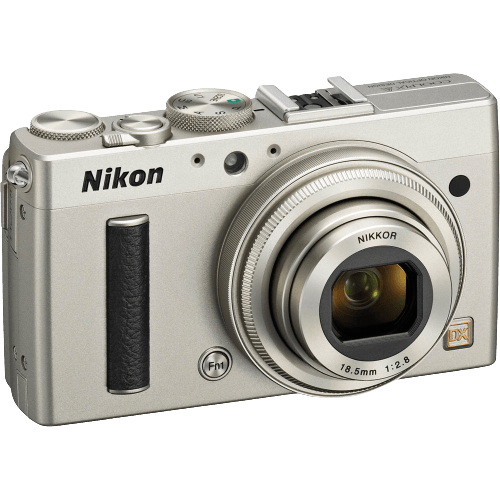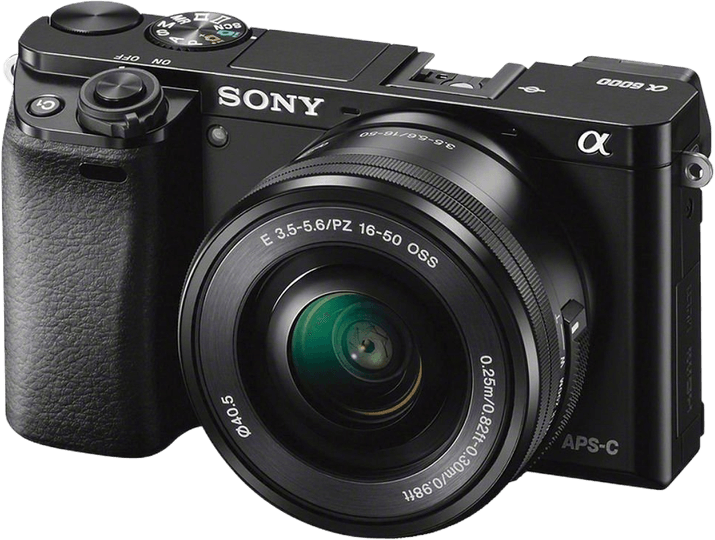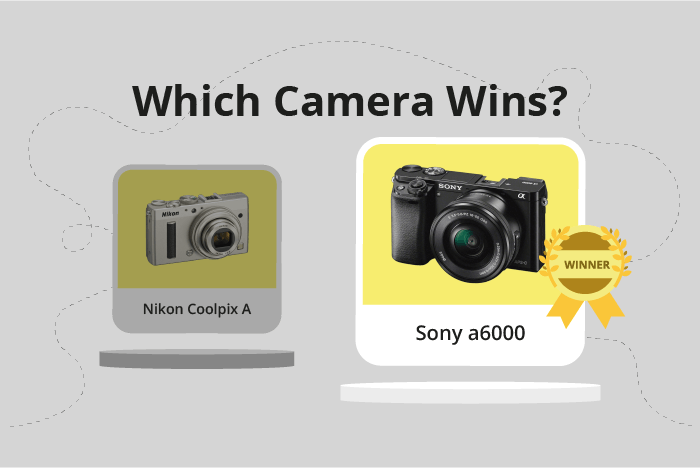Nikon Coolpix A vs Sony a6000 Comparison
Nikon Coolpix A

Sony a6000

The Sony a6000 outperforms the Nikon Coolpix A with a score of 57/100 compared to 45/100. Both cameras share similarities such as their announcement in the early 2010s and compact sizes. The Sony a6000’s edge comes from its mirrorless design, providing a more advanced shooting experience. Additionally, it was launched at a lower price of $799 compared to the Nikon Coolpix A’s $1100. However, the Nikon Coolpix A has a slightly lighter weight at 299g, whereas the Sony a6000 weighs 344g. Despite this advantage, the Sony a6000 remains the better option due to its higher score and more advanced features.
Nikon Coolpix A vs Sony a6000 Overview and Optics
The Sony a6000 wins the optics comparison with a score of 67/100, while the Nikon Coolpix A scores 50/100. Both cameras share common specifications, such as a CMOS sensor, APS-C sensor size, and no image stabilisation. However, there are aspects where each camera excels.
The Sony a6000 outperforms the Nikon Coolpix A in several areas. With 24.3 megapixels, it offers higher resolution compared to the Coolpix A’s 16.2 megapixels. This allows for more detailed images and better cropping flexibility. Additionally, the a6000 has a faster shooting speed of 11 frames per second, making it more suitable for capturing fast-moving subjects. Its Bionz X processor is more advanced than the Coolpix A’s Expeed 2, contributing to improved image processing. The a6000 also has a slightly higher DXOMARK sensor score of 82, compared to 80 for the Coolpix A. Lastly, the Sony a6000 features a Sony E lens mount, allowing users to swap lenses for different photography needs.
On the other hand, the Nikon Coolpix A has a fixed lens mount, which can be both a limitation and an advantage. While it doesn’t offer the flexibility of interchangeable lenses, it also simplifies the camera’s design and eliminates the need to purchase additional lenses.
Taking these factors into account, the Sony a6000 is the better camera in terms of optics, offering higher resolution, faster shooting speed, a more advanced processor, and the flexibility of interchangeable lenses. However, the Nikon Coolpix A may appeal to those who prefer a simpler, more compact camera with a fixed lens.
Nikon Coolpix A vs Sony a6000 Video Performance
The Sony a6000 outperforms the Nikon Coolpix A in video capabilities, scoring 56 out of 100 compared to the Coolpix A’s score of 43. Both cameras share common video specifications, such as Full HD video resolution (1920 x 1080) and the lack of built-in time-lapse functionality.
The Sony a6000 surpasses the Nikon Coolpix A in video frame rate, offering a maximum of 60fps while the Coolpix A only reaches 30fps. This higher frame rate allows the a6000 to capture smoother and more fluid motion in videos, making it a better choice for recording fast-moving subjects or action scenes.
Although the Nikon Coolpix A has a lower video score, it may still be suitable for casual video recording or for those who prioritize photography over videography. However, its lower frame rate of 30fps could be limiting for users requiring more advanced video features or better motion capture.
Considering the video capabilities of both cameras, the Sony a6000 is the clear winner due to its higher frame rate of 60fps, which results in smoother video capture. The Nikon Coolpix A, while still offering Full HD resolution, falls short in this aspect with its 30fps frame rate. Therefore, for those prioritizing video performance, the Sony a6000 is the superior choice.
Nikon Coolpix A vs Sony a6000 Features and Benefits
The Nikon Coolpix A and Sony a6000 both achieve a feature score of 41 out of 100. This equality in scores reveals that these cameras share many specifications, yet also have unique advantages.
Both cameras have a 3-inch screen size and nearly identical screen resolutions, with the Coolpix A at 921,000 dots and the a6000 at 921,600 dots. Neither camera has a touchscreen, but both have flip screens, allowing for versatile shooting angles. GPS is absent in both models, but both cameras have WiFi capabilities, enabling easy image transfer and remote control. Neither camera has Bluetooth.
While the overall feature scores are the same, each camera has its own strengths. The Nikon Coolpix A excels in its compact size, making it highly portable and convenient for travel photography. Its sleek design and user-friendly interface appeal to both beginners and experienced photographers. Additionally, the Coolpix A has a wide range of creative modes and filters, allowing users to experiment with their photography.
On the other hand, the Sony a6000 stands out with its fast autofocus system and excellent low-light performance. This camera is well-suited for capturing action shots and producing high-quality images in challenging lighting conditions. Furthermore, the a6000 has a more extensive lens selection, providing greater flexibility in composing shots and achieving desired effects.
Both the Nikon Coolpix A and Sony a6000 offer valuable features and cater to different photography needs. The Coolpix A is a compact and creative option, while the a6000 excels in capturing fast-moving subjects and performing well in low light. Ultimately, the choice between these cameras depends on the individual photographer’s preferences and requirements.
Nikon Coolpix A vs Sony a6000 Storage and Battery
The Sony a6000 outperforms the Nikon Coolpix A in storage and battery with a score of 21/100, while the Nikon Coolpix A scores 13/100. Both cameras have a single memory card slot and accept SD, SDHC, and SDXC cards. However, the Sony a6000 also supports Memory Stick Pro Duo and Pro-HG Duo cards, giving it an advantage in storage options.
Moreover, the Sony a6000 has a longer battery life, providing 360 shots compared to the Nikon Coolpix A’s 230 shots. Both cameras use different battery types: the Sony a6000 uses the NP-FW50, while the Nikon Coolpix A uses the EN-EL20. Neither camera offers USB charging.
The Nikon Coolpix A does not have any advantages in storage and battery over the Sony a6000. The Sony a6000’s longer battery life and additional memory card compatibility make it the superior choice in this category.
Nikon Coolpix A vs Sony a6000 – Our Verdict
Are you still undecided about which camera is right for you? Have a look at these popular comparisons that feature the Nikon Coolpix A or the Sony a6000:

